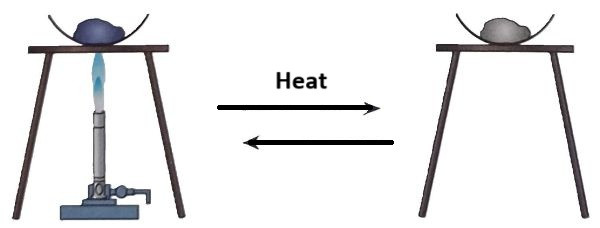Reversible Reactions and Equilibrium
In this section, we will explore reversible reactions and equilibrium. A reversible reaction is one in which the products can react to form the original reactants. Understanding reversible reactions and the conditions under which equilibrium is reached is important for controlling chemical processes in both laboratories and industry.
Reversible Reactions
A reversible reaction is a type of chemical reaction in which the products can react to form the original reactants, and vice versa. This means that the reaction can go in both directions. The symbol used to represent a reversible reaction is a double arrow (⇌), which shows that the reaction can proceed in both directions, depending on the conditions.
Examples of Reversible Reactions
Heating Ammonium Chloride:
When ammonium chloride (NH₄Cl) is heated, it decomposes to form ammonia gas (NH₃) and hydrogen chloride gas (HCl):
$$\text{NH₄Cl (s)} \rightleftharpoons \text{NH₃ (g)} + \text{HCl (g)}$$
Upon cooling, the ammonia and hydrogen chloride gases can recombine to form solid ammonium chloride again. This demonstrates that the reaction is reversible.

Heating Hydrated Copper(II) Sulphate:
When hydrated copper(II) sulphate (CuSO₄·5H₂O) is heated, it loses its water of crystallisation and becomes anhydrous copper(II) sulphate (CuSO₄):
$$\text{CuSO₄·5H₂O (s)} \rightleftharpoons \text{CuSO₄ (s)} + 5\text{H₂O (g)}$$
If water is added to the anhydrous copper(II) sulphate, the reaction reverses, and the hydrated copper(II) sulphate forms again.
These reactions are examples of reversible reactions, where the forward reaction (heating) and the backward reaction (cooling or adding water) can both occur under different conditions.

Equilibrium
Equilibrium is the state of a reversible reaction when the rates of the forward and backward reactions are equal. At equilibrium, the concentrations of the reactants and products remain constant, even though both reactions are still happening. However, this does not mean that the reactions have stopped; they are simply occurring at the same rate in both directions.
- Dynamic Equilibrium: The key feature of equilibrium is that it is dynamic — both the forward and reverse reactions continue to occur, but there is no overall change in the concentrations of reactants and products.
Equilibrium Conditions
Equilibrium can only be achieved under certain conditions, and the position of equilibrium can be influenced by changes in concentration, temperature, and pressure. These changes can shift the equilibrium to favour either the forward or backward reaction. This principle is known as Le Chatelier's Principle.
Changing Concentration
If the concentration of either the reactants or the products is changed, the position of equilibrium will shift to counteract this change. This is in line with Le Chatelier’s Principle.
- Increasing the concentration of a reactant: If you add more of a reactant, the equilibrium will shift to the right, favouring the formation of more products.
- Increasing the concentration of a product: If you add more of a product, the equilibrium will shift to the left, favouring the formation of more reactants.
For example, in the reaction of nitrogen and hydrogen to form ammonia:
$$\text{N₂ (g)} + 3\text{H₂ (g)} \rightleftharpoons 2\text{NH₃ (g)}$$
If more nitrogen (N₂) or hydrogen (H₂) is added, the equilibrium will shift to the right, producing more ammonia (NH₃).
Changing Temperature
The effect of temperature on equilibrium depends on whether the forward reaction is exothermic or endothermic.
- If the reaction is exothermic (releases heat), increasing the temperature will shift the equilibrium to the left, favouring the reverse reaction, which absorbs heat.
- If the reaction is endothermic (absorbs heat), increasing the temperature will shift the equilibrium to the right, favouring the forward reaction, which absorbs heat.
For example, in the reaction to form ammonia:
$$\text{N₂ (g)} + 3\text{H₂ (g)} \rightleftharpoons 2\text{NH₃ (g)} \quad \Delta H = -92 \text{kJ/mol}$$
This reaction is exothermic, so increasing the temperature will shift the equilibrium to the left, reducing the production of ammonia.
Changing Pressure (for Gaseous Reactions)
For reactions involving gases, changing the pressure can also shift the position of equilibrium. This only applies if there is a change in the number of moles of gas on either side of the reaction.
- Increasing the pressure will favour the side of the reaction with fewer moles of gas, as this will reduce the pressure.
- Decreasing the pressure will favour the side with more moles of gas.
For example, in the following reaction:
$$\text{N₂ (g)} + 3\text{H₂ (g)} \rightleftharpoons 2\text{NH₃ (g)}$$
There are 4 moles of gas on the left and 2 moles of gas on the right. Increasing the pressure will shift the equilibrium to the right, favouring the production of ammonia.
Summary
In summary, reversible reactions are reactions where the products can react to form the original reactants, and equilibrium is reached when the rates of the forward and backward reactions are equal. The position of equilibrium can be influenced by factors such as concentration, temperature, and pressure, and these changes are explained by Le Chatelier's Principle. By understanding these factors, we can control reactions to optimise product yield in various industrial processes.
